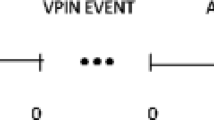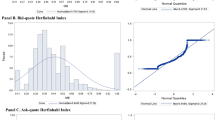Abstract
This study examines the interaction between dynamic limit order placement activities and market quality around the two system upgrades by the Australian Securities Exchange (ASX) which aims at reducing the latency of trades. We show that after the 2006 system upgrade from Stock Exchange Automated Trading System to Integrated Trading System, liquidity falls and short-term volatility heightens. Lower latency provides capacity for traders to position themselves to take liquidity when it is cheap. After the second upgrade in 2010 (launch of ASX Trade), the harmful effect reverses. Our evidence shows that in large-capitalisation stocks, algorithmic trading/high-frequency trading provides liquidity and stabilises the price when short-term volatility is high. Since we find that the market quality could be unfavourably affected after a system upgrade (i.e., the 2006 system upgrade), regulators need to be prepared for near-time reactions and rapid investigations in the event of market stress.
Similar content being viewed by others
Notes
ASX200 is Australia’s primary stock market index and contains the top 200 ASX listed companies by float-adjusted market capitalisation. ASX200 index came into operation in 2000 and acts as the benchmark for Australian equity performance.
According to Frino et al. (2011), AT/HFT participation in Australia, in terms of daily dollar value proportion of HFT trades, ranged between 30 and 80% for the period of October 2006 and October 2009. According to ASIC reports, as of November 2010, ASX participants estimate their levels of AT/HFT at 30–40% of total volumes traded. From May to July 2012, the percentages of HFT in the total number of orders for new, revised, and cancelled orders are estimated at 61%, 60%, and 59%, respectively.
For robustness, we extend the event window to 2 months and our conclusion remains largely unchanged.
The ratio can exceed 100% due to the possibility of multiple revisions for each submission.
This definition is somewhat arbitrary. Hasbrouck and Saar (2013) argue that longer runs represent low-latency activity. For robustness, we include all runs with messages > 1. For example, a limit order submission that is followed by a full execution has the message of 1. If the order is revised once prior to its full execution, it has the message of 2. Unlike Hasbrouck and Saar (2013), we are utilising order book data that has a unique order identifier which allows us to track down the order events with no issue of misclassification, hence our measure of strategic runs is fairly accurate. Our conclusion, however, becomes less consistent with this new definition as it invariably inflates the value of DLOPA when limit orders stay in the book for a prolonged period of time. The introduction of noise to the measure makes it difficult to generate a sensible conclusion. A viable avenue for future research is to improve the measure by considering a different time-weighting mechanism given that our data contains a unique order identifier.
Unlike Hasbrouck and Saar (2013) who impute links between cancellation and resubmission of orders based on how close between consecutive events (within 100 ms) where the orders matched with order types and size, SIRCA provides unique order identifiers which allow us to track the event sequence (submission, revision, cancellation or execution) of each order without error.
For details of how the time-weighting is computed, see Footnote 16 of Hasbrouck and Saar (2013).
References
Ahn, H. J., Bae, K. H., & Chan, K. (2001). Limit orders, depth and volatility: Evidence from the stock exchange of Hong Kong. Journal of Finance, 56(2), 767–788. https://doi.org/10.1111/0022-1082.00345
Bacidore, J., Battalio, R., & Jennings, R. (2003). Order submission strategies, liquidity supply, and trading in pennies on the New York Stock Exchange. Journal of Financial Markets, 6(3), 337–362. https://doi.org/10.1016/S1386-4181(03)00003-X
Brogaard, J., Hagströmer, B., Nordén, L., & Riordan, R. (2015). Trading fast and slow: Colocation and liquidity. The Review of Financial Studies, 28(12), 3407–3443. https://doi.org/10.1093/rfs/hhv045
Buti, S., & Rindi, B. (2013). Undisclosed orders and optimal submission strategies in a limit order market. Journal of Financial Economics, 109(3), 797–812. https://doi.org/10.1016/j.jfineco.2013.04.002
Cao, C., Hansch, O., & Wang, X. (2008). Order placement strategies in a pure limit order book market. Journal of Financial Research, 31(2), 113–140. https://doi.org/10.1111/j.1475-6803.2008.00234.x
Cohen, K. J., Maier, S. F., Schwartz, R. A., & Whitcomb, D. K. (1981). Transaction costs, order placement strategy, and existence of the bid-ask spread. Journal of Political Economy, 89(2), 287–305. https://doi.org/10.1086/260966
Cont, R., & Kukanov, A. (2017). Optimal order placement in limit order markets. Quantitative Finance, 17(1), 21–39. https://doi.org/10.1080/14697688.2016.1190030
Easley, D., Hendershott, T., & Ramadorai, T. (2014). Leveling the trading field. Journal of Financial Markets, 17, 65–93. https://doi.org/10.1016/j.finmar.2013.06.003
Fong, K., & Liu, W. M. (2010). Limit order revisions. Journal of Banking and Finance, 34(8), 1873–1885. https://doi.org/10.1016/j.jbankfin.2009.12.010
Frino, A., Lepone, A., & Mistry, M. (2011). The new breed of Market Participants: High frequency trading: Evidence from the Australian Stock Exchange. Discipline of Finance, University of Sydney. Working Paper.
Fung, W., & Hsieh, D. A. (1997). Empirical characteristics of dynamic trading strategies: The case of hedge funds. Review of Financial Studies, 10(2), 275–302. https://doi.org/10.1093/rfs/10.2.275
Gai, J., Ye, M. & Yao, C. (2013). The externalities of high frequency trading. WBS Finance Group Research Paper.
Guy, D. (2011). High frequency trading in foreign exchange markets. Bank for International Settlements (BIS). BIS Working Group. Available at: https://www.bis.org/review/r111013e.pdf
Harris, L., & Hasbrouck, J. (1996). Market vs. limit orders: The SuperDot evidence on order submission strategy. Journal of Financial and Quantitative Analysis, 31(2), 213–231. https://doi.org/10.2307/2331180
Hasbrouck, J., & Saar, G. (2013). Low-latency trading. Journal of Financial Markets, 16(4), 646–679. https://doi.org/10.1016/j.finmar.2013.05.003
Hendershott, T., & Moulton, P. C. (2011). Automation, speed, and stock market quality: The NYSE’s hybrid. Journal of Financial Markets, 14(4), 568–604. https://doi.org/10.1016/j.finmar.2011.02.003
Jain, P. K., Jain, P., & McInish, T. H. (2016). Does high-frequency trading increase systemic risk? Journal of Financial Markets, 31, 1–24. https://doi.org/10.1016/j.finmar.2016.09.004
Kissell, R., Glantz, M., & Malamut, R. (2004). A practical framework for estimating transaction costs and developing optimal trading strategies to achieve best execution. Finance Research Letters, 1(1), 35–46. https://doi.org/10.1016/S1544-6123(03)00004-7
Le, A. T., Le, T. H., Liu, W. M., & Fong, K. Y. (2020). Multiple duration analyses of dynamic limit order placement strategies and aggressiveness in a low-latency market environment. International Review of Financial Analysis, 72, 101575. https://doi.org/10.1016/j.irfa.2020.101575
Le, A. T., Le, T. H., Liu, W. M., & Fong, K. Y. (2021). Dynamic limit order placement strategies: Survival analysis with a multiple-spell duration model. Annals of Operations Research, 297, 241–275. https://doi.org/10.1007/s10479-019-03384-y
Liu, W.-M. (2009). Monitoring and limit order submission risks. Journal of Financial Markets, 12(1), 107–141. https://doi.org/10.1016/j.finmar.2008.04.003
Lo, A. W., MacKinlay, A. C., & Zhang, J. (2002). Econometric models of limit order executions. Journal of Financial Economics, 65(1), 31–71. https://doi.org/10.1016/S0304-405X(02)00134-4
Menkveld, A. J. (2013). High frequency trading and the new market makers. Journal of Financial Markets, 16(4), 712–740. https://doi.org/10.1016/j.finmar.2013.06.006
Murray, H., Pham, T. P., & Singh, H. (2016). Latency reduction and market quality: The case of the Australian Stock Exchange. International Review of Financial Analysis, 46, 257–265. https://doi.org/10.1016/j.irfa.2015.09.001
Parlour, C. (1998). Price dynamics in limit order markets. Review of Financial Studies, 11(4), 789–816. https://doi.org/10.1093/rfs/11.4.789
Ranaldo, A. (2004). Order aggressiveness in limit order markets. Journal of Financial Markets, 7(1), 53–74. https://doi.org/10.1016/S1386-4181(02)00069-1
Riordan, R., & Storkenmaier, A. (2012). Latency, liquidity and price discovery. Journal of Financial Markets, 15(4), 416–437. https://doi.org/10.1016/j.finmar.2012.05.003
Van Ness, B. F., Van Ness, R. A., & Watson, E. D. (2015). Canceling liquidity. Journal of Financial Research, 38(1), 3–33. https://doi.org/10.1111/jfir.12051
Yamamoto, R. (2020). Limit order submission risks, order choice, and tick size. Pacific-Basin Finance Journal, 59, 101261. https://doi.org/10.1016/j.pacfin.2019.101261
Author information
Authors and Affiliations
Corresponding author
Additional information
Publisher's Note
Springer Nature remains neutral with regard to jurisdictional claims in published maps and institutional affiliations.
Rights and permissions
About this article
Cite this article
Le, A.T., Le, TH., Liu, WM. et al. Dynamic limit order placement activities and their effects on stock market quality. Ann Oper Res 330, 155–175 (2023). https://doi.org/10.1007/s10479-021-04282-y
Accepted:
Published:
Issue Date:
DOI: https://doi.org/10.1007/s10479-021-04282-y




